Gosia, 2005-11-28 12:10:45
More then 300 trunks!
Not translated yet
comment
Marcin, 2005-11-24 11:36:10
Different Asia
Not translated yet
comment
Marcin, 2005-11-09 15:54:53
Trzy stolice
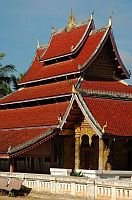 At the end of our stay in Laos we visited three the most popular places - Luang Prabang, Vang Vieng and Vientian. Luang Praban is the old capital of the country – the city of the kings. It is located in the mountains on the Mekong river, and thanks to it the climate is very nice here. There are 33 temples in the city. The colonial houses stand along the main street. There are pubs, shops with souvenirs, travel agencies and temples amongst. At the end of our stay in Laos we visited three the most popular places - Luang Prabang, Vang Vieng and Vientian. Luang Praban is the old capital of the country – the city of the kings. It is located in the mountains on the Mekong river, and thanks to it the climate is very nice here. There are 33 temples in the city. The colonial houses stand along the main street. There are pubs, shops with souvenirs, travel agencies and temples amongst.
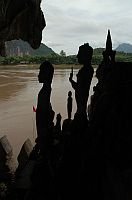 The kings’ palace was the first place we visited in Luang Prabang. We liked it very much. As we were watching one of the exhibitions among the presents to the ruler we noticed a tiny object from Poland - the miniature of the coronation sword of Polish kings which looked like a cheap souvenir from Kraków. What a shame! – we could have given something else. We visited the temples every day for four days and we went on a trip to the cave Pak Ou. There are thousands of Budda statues collected in two caverns. On our way back we visited two villages. In the first one alcoholic beverage made of rice are produced. In the second village people produce paper which contains the leaves and parts of the flowers. The villages live on selling souvenirs and almost in every house there was a shop sometimes quite a big one. The kings’ palace was the first place we visited in Luang Prabang. We liked it very much. As we were watching one of the exhibitions among the presents to the ruler we noticed a tiny object from Poland - the miniature of the coronation sword of Polish kings which looked like a cheap souvenir from Kraków. What a shame! – we could have given something else. We visited the temples every day for four days and we went on a trip to the cave Pak Ou. There are thousands of Budda statues collected in two caverns. On our way back we visited two villages. In the first one alcoholic beverage made of rice are produced. In the second village people produce paper which contains the leaves and parts of the flowers. The villages live on selling souvenirs and almost in every house there was a shop sometimes quite a big one.
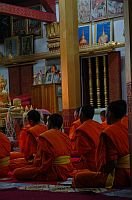 When we were visiting one of the temples in Luang Prabang I was accosted by a monk. We were talking for a while and he invited us to his room. It was similar to the rooms in Polish boarding schools or students hostels (bed, desk, bookcase, on the walls posters with youth idols). Then he wanted us to teach English. The two lectures took place in a small house standing at the rear of the temple. The first group of students were mostly young monks dressed in orange robes. The second group were „civvies” aged between 17 and 35 years old. It was very nice and everyone tried to do his best. When we were visiting one of the temples in Luang Prabang I was accosted by a monk. We were talking for a while and he invited us to his room. It was similar to the rooms in Polish boarding schools or students hostels (bed, desk, bookcase, on the walls posters with youth idols). Then he wanted us to teach English. The two lectures took place in a small house standing at the rear of the temple. The first group of students were mostly young monks dressed in orange robes. The second group were „civvies” aged between 17 and 35 years old. It was very nice and everyone tried to do his best.
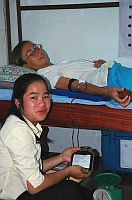 The next thing we gave to the local community was blood donation. We were encouraged to do it after reading the leaflets where we found out that here the blood unit cost 30-40$ and people often die because they do not have any money. The local branch of the Red Cross organization earns money providing therapeutic massage and herbal sauna. To combine business with pleasure we suggested Gosia to have a massage. The next thing we gave to the local community was blood donation. We were encouraged to do it after reading the leaflets where we found out that here the blood unit cost 30-40$ and people often die because they do not have any money. The local branch of the Red Cross organization earns money providing therapeutic massage and herbal sauna. To combine business with pleasure we suggested Gosia to have a massage.
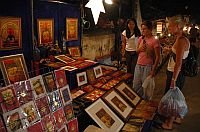 In the evening the main part of the street has been closed and changed intoa market with souvenirs. The goods have been spread on the mats and illuminated by a light bulb hanging from a stick. You could buy almost everything there – from bric-a-brac, lampshades, clothes to bedding. People could satiate their appetite eating in cheap meals. The great plate of vegetarian dish cost 50 cents. In the evening the main part of the street has been closed and changed intoa market with souvenirs. The goods have been spread on the mats and illuminated by a light bulb hanging from a stick. You could buy almost everything there – from bric-a-brac, lampshades, clothes to bedding. People could satiate their appetite eating in cheap meals. The great plate of vegetarian dish cost 50 cents.
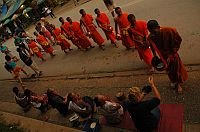 It was possible to listen to monks’ singing, who gathered in 18 temples. We liked it very much. Although, most of tourists got up very early (before 6am) to see the distribution of food to the monks. On the pavement the old ladies and tourists were staying with baskets full of glutinous rice. The monks were walking in the row with bowls which were filled with food. The “ceremony” was full of camera flashes. It was possible to listen to monks’ singing, who gathered in 18 temples. We liked it very much. Although, most of tourists got up very early (before 6am) to see the distribution of food to the monks. On the pavement the old ladies and tourists were staying with baskets full of glutinous rice. The monks were walking in the row with bowls which were filled with food. The “ceremony” was full of camera flashes.
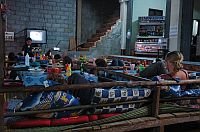 The rulers of Laos never lived in Vang Vieng. In fact, it is the capital of tourist decadency. The first thing we saw there were pubs in which on the bed the strangers from west were lying watching “Friends” and sipping drinks. One of the most popular beverages was so called "happy shake", a fruit cocktail with marijuana. The „happy” menu contains also tea, pancakes and pizza. It was possibile to order a dish with hallcinogenic mushrooms and opium. The rulers of Laos never lived in Vang Vieng. In fact, it is the capital of tourist decadency. The first thing we saw there were pubs in which on the bed the strangers from west were lying watching “Friends” and sipping drinks. One of the most popular beverages was so called "happy shake", a fruit cocktail with marijuana. The „happy” menu contains also tea, pancakes and pizza. It was possibile to order a dish with hallcinogenic mushrooms and opium.
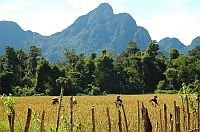 Nonetheless, the village has a lot of charm. There are a few more attractions ”rafting” on the tractor’s tube (about 40 minutes, or with stops in the waterfront pubs – a whole day) and sightseeing in the beautiful area. In the nearby mountains there are plenty of interesting caves. Nonetheless, the village has a lot of charm. There are a few more attractions ”rafting” on the tractor’s tube (about 40 minutes, or with stops in the waterfront pubs – a whole day) and sightseeing in the beautiful area. In the nearby mountains there are plenty of interesting caves.
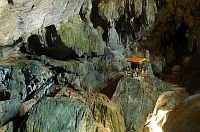 We chose the two Phu Kham and Pyton. If you do not have a torch, you will visit only the first part of the cave Phu Kham. It is much more interesting to venture into the darkness. Our good acquaintance from the Czech Republic recommended us to visit the tunel in the cave which we did not find. We were penetrating the nooks of the cavern for two hours. When we left the cave we had a bath in a small but deep pond with cool and turquoise water. There were swings over the water and the ladder which helped to jump from the branch prepared for tourists. We chose the two Phu Kham and Pyton. If you do not have a torch, you will visit only the first part of the cave Phu Kham. It is much more interesting to venture into the darkness. Our good acquaintance from the Czech Republic recommended us to visit the tunel in the cave which we did not find. We were penetrating the nooks of the cavern for two hours. When we left the cave we had a bath in a small but deep pond with cool and turquoise water. There were swings over the water and the ladder which helped to jump from the branch prepared for tourists.
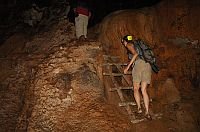 Even though it was late we decided to go to the second cave. "Pyton" is two kilometres long and we were visiting it with its owner and guide (he has got three more caves). After an hour we had to go back because it was getting dark. First we had to marsh 30 minutes in the darkness through muddy rice fields and next one and a half hour ride. We forded the river twice (there were bridges, but paid). On our way we got a flat tyre and we reached Vang Vieng about 19:30 pm. The next day we chose kayaks instead of tubes and we headed to Wientian. The best fun was when we had to cover the screes and jump down from the top of the eight-metre rock. Even though it was late we decided to go to the second cave. "Pyton" is two kilometres long and we were visiting it with its owner and guide (he has got three more caves). After an hour we had to go back because it was getting dark. First we had to marsh 30 minutes in the darkness through muddy rice fields and next one and a half hour ride. We forded the river twice (there were bridges, but paid). On our way we got a flat tyre and we reached Vang Vieng about 19:30 pm. The next day we chose kayaks instead of tubes and we headed to Wientian. The best fun was when we had to cover the screes and jump down from the top of the eight-metre rock.
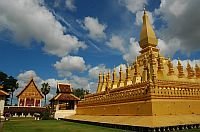 The last stop in Laos was in the capital of the country - Wientian. We spent there quite a lot of time, mainly because we had to prolog the Laotian visas and we get the Thai ones. We visited the biggest monument of the country Pha That Luang and so called Budda’s Park, where several dozen statues of Budda and Hindu figures are gathered. The place itself was interesting but it was a little bit kitschy. The last stop in Laos was in the capital of the country - Wientian. We spent there quite a lot of time, mainly because we had to prolog the Laotian visas and we get the Thai ones. We visited the biggest monument of the country Pha That Luang and so called Budda’s Park, where several dozen statues of Budda and Hindu figures are gathered. The place itself was interesting but it was a little bit kitschy.
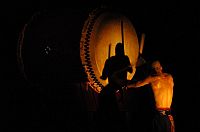 We are leaving Wientian tomorrow. We stayed one day longer because of the “tickets free” Japanese drummers’ concert - as we thought. It occurred later that there was only one musician performing in front of us, rarely two of them, and we were disappointed. To our surprise the show was magnificent. The Japanese had a great contact with the audience and played as if there were ten musicians not just one. We left delighted and Gosia kept repeating that she wanted to get the biggest drum for herself. We are leaving Wientian tomorrow. We stayed one day longer because of the “tickets free” Japanese drummers’ concert - as we thought. It occurred later that there was only one musician performing in front of us, rarely two of them, and we were disappointed. To our surprise the show was magnificent. The Japanese had a great contact with the audience and played as if there were ten musicians not just one. We left delighted and Gosia kept repeating that she wanted to get the biggest drum for herself.
comment
Marcin, 2005-11-06 13:23:00
Northern Laos
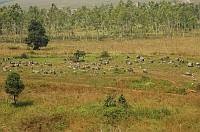 When the girls left we went to Phonsavan. The guidebook suggested that it is one of the most known tourist places in Laos. We were surprised not to meet a single fellow visiting the place for quite a few hours. It did not suit us because we wanted to go on a trip to the valley of amphoras, and the price of that trip depended on the number of the people taking part in it. We both were looking for tourists who would like to go on such a trip in the whole city and we managed to gather 9 people – so the price could be 3-4$ per person. When in the evening we went to the tourist agency there were 11 people ready to go but the price we heard was 6$ 50 cents. We proposed 5$. The travel agent agreed on condition that we would take another tour guide. Then a boy from Australia said that 1$ 50 cents is not a big amount of money for him and he would like to have a good guide (but nobody had said that the second guide, the cheaper, could be a bad one). Before we had time to react everyone in the group agreed with the Australian. We looked at each other in astonishment, we were both struck dumb as we have never met such simpletons. They paid twice for the same of their own free will. We did not want to go with them anywhere so we just left the office.
When the girls left we went to Phonsavan. The guidebook suggested that it is one of the most known tourist places in Laos. We were surprised not to meet a single fellow visiting the place for quite a few hours. It did not suit us because we wanted to go on a trip to the valley of amphoras, and the price of that trip depended on the number of the people taking part in it. We both were looking for tourists who would like to go on such a trip in the whole city and we managed to gather 9 people – so the price could be 3-4$ per person. When in the evening we went to the tourist agency there were 11 people ready to go but the price we heard was 6$ 50 cents. We proposed 5$. The travel agent agreed on condition that we would take another tour guide. Then a boy from Australia said that 1$ 50 cents is not a big amount of money for him and he would like to have a good guide (but nobody had said that the second guide, the cheaper, could be a bad one). Before we had time to react everyone in the group agreed with the Australian. We looked at each other in astonishment, we were both struck dumb as we have never met such simpletons. They paid twice for the same of their own free will. We did not want to go with them anywhere so we just left the office.
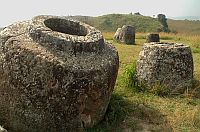 Eventually, we saw the amphoras but we went on foot to the valley. Surprisingly, they were nearer than the guidebook says (only 11 kilometres – it equals 2 and a half hours of march). We met there “our group” and it occurred that the boy who suggested a higher price did not arrive to the valley at all. There on the area of about 1ha (2.5 acres) we could see 250 stone amphoras. The biggest one weighted 6 tons and it was 2.5 metres high. There are two big clusters of the amphoras and some more tiny in the nearest surrounding. The origin and purpose of the great jugs is still not known. Unfortunately almost 20% of them were destroyed during the American air raids of the northern part of the country in the time of war with Vietnam.
Eventually, we saw the amphoras but we went on foot to the valley. Surprisingly, they were nearer than the guidebook says (only 11 kilometres – it equals 2 and a half hours of march). We met there “our group” and it occurred that the boy who suggested a higher price did not arrive to the valley at all. There on the area of about 1ha (2.5 acres) we could see 250 stone amphoras. The biggest one weighted 6 tons and it was 2.5 metres high. There are two big clusters of the amphoras and some more tiny in the nearest surrounding. The origin and purpose of the great jugs is still not known. Unfortunately almost 20% of them were destroyed during the American air raids of the northern part of the country in the time of war with Vietnam.
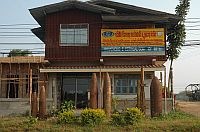 Other remains of that time are unexploded bombs stuck in the land. Much of the military scrap (mostly the shells) are used by local people as material for building the fences, flower stands, and all kinds of supports, etc. A few organizations “clean” Laos from landmines and missiles but still many people (especially children) die or loose legs or arms. Because of unexploded bombs it is suggested not to turn aside of the paths in Laos.
Other remains of that time are unexploded bombs stuck in the land. Much of the military scrap (mostly the shells) are used by local people as material for building the fences, flower stands, and all kinds of supports, etc. A few organizations “clean” Laos from landmines and missiles but still many people (especially children) die or loose legs or arms. Because of unexploded bombs it is suggested not to turn aside of the paths in Laos.
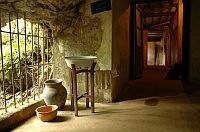 Our next destination was Vieng Xai –a tiny village in the mountains. It is famous for the shelters cut in the rocks, where the leaders of the communist party (also the later president) were hiding during the eight years of bombing. It is interesting that officially there was no war in Laos. The American pilots flew dressed in casual clothes and in case of being shoot down they had to bite a capsule with poison. In Laos every 8 minutes a bomb exploded between years 1964 and 1972.
Our next destination was Vieng Xai –a tiny village in the mountains. It is famous for the shelters cut in the rocks, where the leaders of the communist party (also the later president) were hiding during the eight years of bombing. It is interesting that officially there was no war in Laos. The American pilots flew dressed in casual clothes and in case of being shoot down they had to bite a capsule with poison. In Laos every 8 minutes a bomb exploded between years 1964 and 1972.
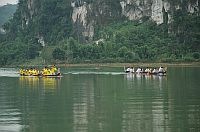 Before visiting the shelters we spoke Russian to a local government worker we met there. He told us that he had been studying in Stalingrad 30 years ago. Then we got our guide and we set off. On our way to the caves we noticed a huge bush of poinsettia. The guide explained that the Laotian people eat the leaves with meat. After a while he added with a smile that his fellows eat everything.
Before visiting the shelters we spoke Russian to a local government worker we met there. He told us that he had been studying in Stalingrad 30 years ago. Then we got our guide and we set off. On our way to the caves we noticed a huge bush of poinsettia. The guide explained that the Laotian people eat the leaves with meat. After a while he added with a smile that his fellows eat everything.
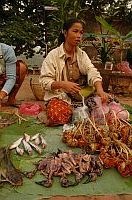 And it is truth. We saw worms, wasps and their larvae, lizards, sparrows, squirrels, cats, grasshoppers, wild birds and many different animals (unknown to us) on the market stalls and on the menu in the restaurants. We learnt from the guidebook that a lot of Laotian people hunt. Gosia and me do not eat so many different things. As we were trying to save some extra money our main dish (in Laos, Cambodia and Vietnam) consisted of fried rice with vegetables and/or an egg. It was really good, sometimes it was even tasty but at the end of our stay in Laos we had enough. Although we tried to make our dish different we did not succeeded. Once I got some spicy soup with the chunks of fish (not scaled) instead of the fish stew.
And it is truth. We saw worms, wasps and their larvae, lizards, sparrows, squirrels, cats, grasshoppers, wild birds and many different animals (unknown to us) on the market stalls and on the menu in the restaurants. We learnt from the guidebook that a lot of Laotian people hunt. Gosia and me do not eat so many different things. As we were trying to save some extra money our main dish (in Laos, Cambodia and Vietnam) consisted of fried rice with vegetables and/or an egg. It was really good, sometimes it was even tasty but at the end of our stay in Laos we had enough. Although we tried to make our dish different we did not succeeded. Once I got some spicy soup with the chunks of fish (not scaled) instead of the fish stew.
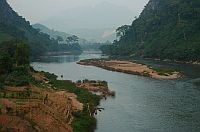 The guidebook suggested the cruise from Nong Khiaw to Muang Ngoi Neua, but we liked the first place best so we stayed there longer. We really liked the landscapes - the soaring mountains surrounding the village. There are similar landscapes in the northern Laos but those near Nong Khiaw we found especially beautiful.
The guidebook suggested the cruise from Nong Khiaw to Muang Ngoi Neua, but we liked the first place best so we stayed there longer. We really liked the landscapes - the soaring mountains surrounding the village. There are similar landscapes in the northern Laos but those near Nong Khiaw we found especially beautiful.
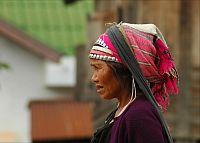 That time we travelled longer than usual and finally reached Muang Sing. The main tourist attraction there are colourfully dressed tribes in the mountains and the villages that can be visited on foot or riding on bikes. We chose the second way, we were riding and cursing the Laotian bikes which were smaller than ours and we had trouble to ride. It was caused not by the bikes themselves but by the climbing path. We reached China, and we saw only two women dressed in national costumes. The man from the Czech Republic who had been there three years ago said that the women sold out their jewellery some tourists bought them and the villages lost their character, for example; satellite dishes have appeared.
That time we travelled longer than usual and finally reached Muang Sing. The main tourist attraction there are colourfully dressed tribes in the mountains and the villages that can be visited on foot or riding on bikes. We chose the second way, we were riding and cursing the Laotian bikes which were smaller than ours and we had trouble to ride. It was caused not by the bikes themselves but by the climbing path. We reached China, and we saw only two women dressed in national costumes. The man from the Czech Republic who had been there three years ago said that the women sold out their jewellery some tourists bought them and the villages lost their character, for example; satellite dishes have appeared.
comment
Marcin, 2005-11-03 13:42:14
Southern Laos
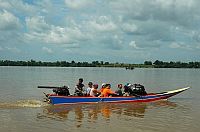 And again we have to catch up with our correspondence through the internet. It is difficult to get access to the Net in Laos but when you have it, it is expensive and rather slow. We started visiting the country with crossing the border. Usually it is nothing special, but that time it was different. When we get to Stung Treng we changed onto the fast boat. It had a car engine and speeded 40 km per hour but we were completely deafened with all the noise it produced. After 30 minutes we reached a customs post (Cambodian). Some travellers told us that customs officers take charge – illegally of course only for a stamp in a passport.
And again we have to catch up with our correspondence through the internet. It is difficult to get access to the Net in Laos but when you have it, it is expensive and rather slow. We started visiting the country with crossing the border. Usually it is nothing special, but that time it was different. When we get to Stung Treng we changed onto the fast boat. It had a car engine and speeded 40 km per hour but we were completely deafened with all the noise it produced. After 30 minutes we reached a customs post (Cambodian). Some travellers told us that customs officers take charge – illegally of course only for a stamp in a passport.
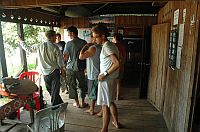 The Cambodian customs officers wanted us to pay 2$ per person but we refused. The English tourist, who was travelling with us, told them that we had heard there is no charge and we can pay for the stamps on condition that they will show us the document informing about that particular regulation. After ten minutes one of the officers gave up and returned our passports with the necessary stamps. On the Laotian side it was not so easy. We tried all the known tricks for example pretending a phone call to the embassy (unfortunately it was Sunday and the Laotian was aware of our helplessness) and threats that did not change the situation. Gosia and I were ready to wait until they allow us to go in without paying the charge but Ania and Iwona did not have much time. An hour later filled with talks and explanations we paid 2$ each and went off.
The Cambodian customs officers wanted us to pay 2$ per person but we refused. The English tourist, who was travelling with us, told them that we had heard there is no charge and we can pay for the stamps on condition that they will show us the document informing about that particular regulation. After ten minutes one of the officers gave up and returned our passports with the necessary stamps. On the Laotian side it was not so easy. We tried all the known tricks for example pretending a phone call to the embassy (unfortunately it was Sunday and the Laotian was aware of our helplessness) and threats that did not change the situation. Gosia and I were ready to wait until they allow us to go in without paying the charge but Ania and Iwona did not have much time. An hour later filled with talks and explanations we paid 2$ each and went off.
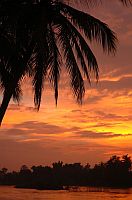 We landed on Don Khon – the island on the Mekong river. We spent two days on resting, we needed them after visiting Angkor and a two day travel to the border. The girls found the strength to see the waterfall but I was sleeping and swinging in a hammock, watching the river running just a meter far from our bungalow. We admired beautiful sunsets there in the evenings, too.
We landed on Don Khon – the island on the Mekong river. We spent two days on resting, we needed them after visiting Angkor and a two day travel to the border. The girls found the strength to see the waterfall but I was sleeping and swinging in a hammock, watching the river running just a meter far from our bungalow. We admired beautiful sunsets there in the evenings, too.
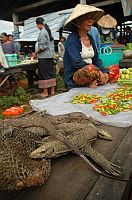 The next city, we went to, did not match to our visualization about Laos. In Pakse there was a supermarket, instead of the market a shopping centre, and to Vientian run luxurious double-decker buses. The prices caught us by surprise – we were counting on stuffing our bellies with cheap fruit but it occurred that it is more expensive here than in Vietnam and Cambodia. Luckily, the next place we visited was different.
The next city, we went to, did not match to our visualization about Laos. In Pakse there was a supermarket, instead of the market a shopping centre, and to Vientian run luxurious double-decker buses. The prices caught us by surprise – we were counting on stuffing our bellies with cheap fruit but it occurred that it is more expensive here than in Vietnam and Cambodia. Luckily, the next place we visited was different.
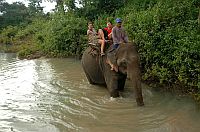 The Bolaven plateau is a net of rice fields, dense woods and climatic villages. Tadlo attracts tourists with its atmosphere and a 10 metre high waterfall, but we (Gosia especially) came there for the elephants, it is the place (the cheapest) where you can ride on an elephant. In the village it occurred that in fact it is more expensive than the price printed in a guidebook. Since I had ridden on an elephant before the girls set off alone on a trip. They were back an hour later and Gosia shouted from a distance that she had sat on the elephant’s neck. Tadlo is worth to stay in longer and go sightseeing but Iwona and Ania did not have enough free time. The Bolaven plateau is a net of rice fields, dense woods and climatic villages. Tadlo attracts tourists with its atmosphere and a 10 metre high waterfall, but we (Gosia especially) came there for the elephants, it is the place (the cheapest) where you can ride on an elephant. In the village it occurred that in fact it is more expensive than the price printed in a guidebook. Since I had ridden on an elephant before the girls set off alone on a trip. They were back an hour later and Gosia shouted from a distance that she had sat on the elephant’s neck. Tadlo is worth to stay in longer and go sightseeing but Iwona and Ania did not have enough free time.
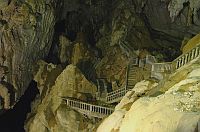 Our next stop was Tha Khaek. There are quite a lot of caves not far from the city. We wanted to explore them and get there on bikes but it was not possible to rent a one. There were only motorcycles, they cost 10$ so we decided to rent a tuk-tuk. The driver took us to the three caves. The first one was small and it was not quite interesting. To get to the second cave we had to buy two tickets, there was light inside and the concrete stairs. The most interesting was the last, not big. Inside there was a temple and a big statue of Budda and several dozen of smaller statues. The women were making candles there and people were praying. The atmosphere was special – it was a pity we could not take any pictures. The surrounding was also beautiful – sharp and massive rocks and green hills. Our next stop was Tha Khaek. There are quite a lot of caves not far from the city. We wanted to explore them and get there on bikes but it was not possible to rent a one. There were only motorcycles, they cost 10$ so we decided to rent a tuk-tuk. The driver took us to the three caves. The first one was small and it was not quite interesting. To get to the second cave we had to buy two tickets, there was light inside and the concrete stairs. The most interesting was the last, not big. Inside there was a temple and a big statue of Budda and several dozen of smaller statues. The women were making candles there and people were praying. The atmosphere was special – it was a pity we could not take any pictures. The surrounding was also beautiful – sharp and massive rocks and green hills.
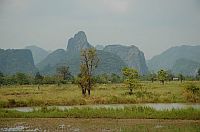 From Tha Khaek we went to Vientian and there we parted. We wanted to see the northern part of the country but Iwona and Ania went to Luang Prabank, Vang Vieng and also to Vientian they had to go back to Bangkok. From Tha Khaek we went to Vientian and there we parted. We wanted to see the northern part of the country but Iwona and Ania went to Luang Prabank, Vang Vieng and also to Vientian they had to go back to Bangkok.
comment
More in archive. | 



















